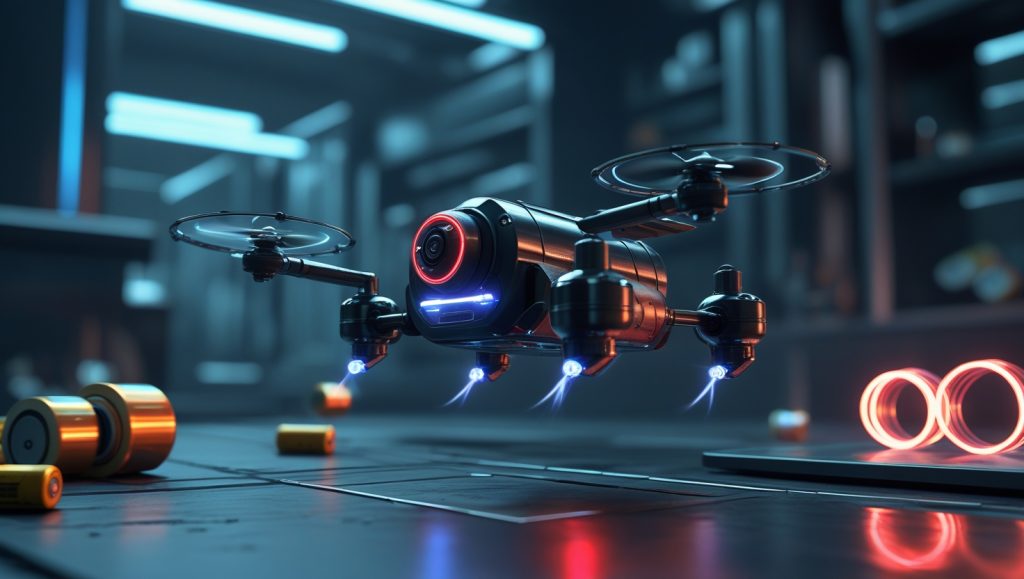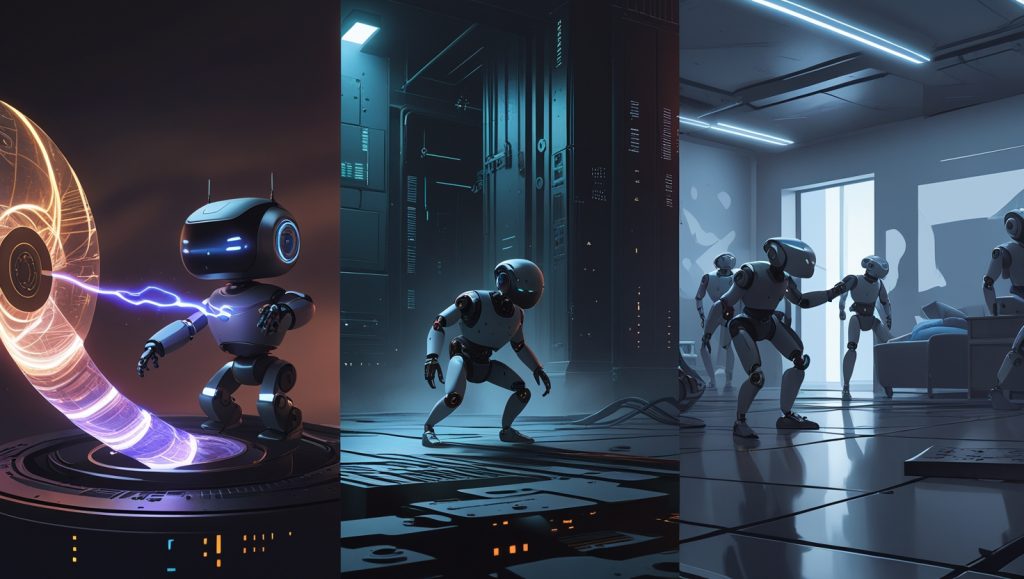How a Miniature Robot Achieves Flight Using Magnetic Fields (No Onboard Power)
In 2025, robotics took a quantum leap when researchers at ETH Zurich unveiled a miniature robot that flies using magnetic fields with no onboard power. This innovation isn’t just a lab experiment—it’s a paradigm shift in how we design machines with magnetic propulsion robotics. By eliminating batteries and wires, this technology opens doors to applications once confined to science fiction, from precision medicine to environmental conservation. But why does this breakthrough matter, and how does it solve real-world problems? Let’s dive deeper into the world of magnetic propulsion robotics.
Why Magnetic Fields Are the Future of Robotics
Traditional robots rely on bulky batteries or tethered power sources, which constrain their size, mobility, and operational lifespan. Magnetic propulsion flips this model by using external electromagnetic coils to generate forces that lift, steer, and power the robot. The result? A device free from energy storage limitations, capable of operating indefinitely as long as the magnetic field persists. This is where magnetic propulsion robotics shines, offering a sustainable, scalable solution. For more on how robotics is evolving, check out Why Robotics in 3D Printing Unlocks Potential.
Why Magnetic Propulsion Robotics Outclasses Traditional Power
Magnetic propulsion robotics doesn’t just eliminate weight—it redefines efficiency. Unlike battery-dependent systems, these robots can be deployed in swarms without the need for constant recharging, making them ideal for long-term missions like ecosystem monitoring or industrial maintenance.
The Physics Behind Magnetic Levitation
The robot’s core contains soft magnetic materials like iron or nickel, which interact with external magnetic fields. By rapidly alternating the polarity and orientation of these fields, engineers create forces such as Lorentz propulsion (for linear motion) and gradient pulls (for vertical lift). For example, NASA’s Mars rovers use similar principles to navigate rugged terrain, but this miniature version operates on a far smaller scale—often under 1 gram—thanks to magnetic propulsion robotics. A similar approach powers UC Berkeley’s tiny flyer, which uses magnetic fields to mimic bumblebee agility—check out the details here. Curious about space applications? See Why Space Robotics Is the Next Gold Rush.
Real-World Applications: Solving Humanity’s Biggest Challenges with Magnetic Propulsion Robotics

1. Medical Miracles: Precision Beyond Human Hands
In 2023, a team at MIT demonstrated a magnetic micro-robot navigating a synthetic artery to dissolve a blood clot. Unlike traditional catheters, which risk damaging vessel walls, this device was steered externally with sub-millimeter precision, a hallmark of magnetic propulsion robotics.
Case Study: Targeted Cancer Therapy
Researchers at Stanford recently used magnetic microbots to deliver chemotherapy drugs directly to pancreatic tumors in mice. The approach reduced off-target toxicity by 70%, a breakthrough highlighted in Nature Nanotechnology. For humans, this could mean fewer side effects and higher survival rates with magnetic propulsion robotics leading the charge. Learn more at How Magnetic Nanobots Are Revolutionizing Oncology.
2. Disaster Response: Reaching the Unreachable
During the 2023 Türkiye-Syria earthquake, rescuers struggled to locate survivors buried under collapsed buildings. Drones with thermal cameras helped, but their bulk limited access to narrow gaps. Magnetic micro-robots, powered by magnetic propulsion robotics, could slip through rubble, transmit live footage, and even deliver water or communication devices. For robotics in rescue, see 2025 Robot Dog Navigation Rescue.
How Magnetic Propulsion Robotics Enhances Rescue Missions
In tight spaces, magnetic propulsion robotics allows these tiny machines to maneuver where larger drones fail. Equipped with sensors, they could map debris fields in real time, offering a lifeline to trapped individuals.
3. Sustainable Industry: Cutting Costs and Carbon Footprints
Oil pipelines and wind turbines require constant inspection for cracks or corrosion. Traditional methods involve shutting down systems and sending human crews—a costly and time-consuming process. Magnetic propulsion robotics changes that.
Shell’s Pilot Program
In 2022, Shell partnered with Siemens to test magnetic inspection robots in offshore rigs. The robots reduced inspection times by 50% and prevented an estimated $4M in potential downtime. With no batteries to replace, they also cut electronic waste by 90% compared to conventional drones—a win for magnetic propulsion robotics. Read more in Shell’s 2023 Sustainability Report.
4. Environmental Guardianship: Monitoring Ecosystems in Real Time
Coral reefs, rainforests, and polar ice caps are ecosystems too fragile for human interference. Swarms of magnetic robots could monitor temperature, pH, or pollutant levels without disturbing habitats, showcasing the versatility of magnetic propulsion robotics.
The Great Barrier Reef Experiment
In 2025, Australia’s CSIRO deployed solar-assisted magnetic robots to track coral bleaching. The data helped scientists predict bleaching events 3 weeks in advance, enabling proactive conservation measures with magnetic propulsion robotics at the core. Explore more at Why Untethered Deep-Sea robots Revolutionize Ocean.
Why This Technology Solves Critical Problems

1. “Why Can’t Regular Drones Do This?”
Battery-powered drones face strict limits: flight time (typically 30 minutes), payload capacity, and size. Magnetic robots bypass these issues entirely with magnetic propulsion robotics. For instance, Harvard’s RoboBee, a pioneering micro-drone, needed a tether for power until magnetic propulsion freed it in 2023.
2. “Why Are Batteries a Problem?”
Lithium-ion batteries degrade over time, pose fire risks, and contribute to e-waste. The World Economic Forum estimates that by 2030, battery waste will exceed 11 million tons annually. Magnetic robots eliminate this burden with magnetic propulsion robotics, aligning with global sustainability goals. See World Economic Forum’s E-Waste Analysis.
3. “Why Is Miniaturization Important?”
Smaller robots access spaces impossible for humans or machines—think jet engine turbines or capillaries in the brain. Miniaturization, driven by magnetic propulsion robotics, also reduces material costs, making large-scale deployments feasible.
Challenges: Bridging the Gap Between Lab and Reality
While magnetic propulsion is revolutionary, scaling it requires overcoming three hurdles:
1. Range and Scalability
Magnetic fields weaken with distance, limiting robots to operating within a few meters of the field generator. Researchers at UC Berkeley are tackling this by developing phased-array coils, similar to radar systems, which extend the effective range to 10 meters for magnetic propulsion robotics.
2. Coordination in Swarms
Directing hundreds of robots in a shared magnetic field is like herding bees. A 2025 study in Science Robotics proposed using AI to assign unique magnetic signatures to each robot, allowing independent control with magnetic propulsion robotics—a method inspired by RFID tagging. Read more at Science Robotics on Swarm Intelligence.
3. Material Science Breakthroughs
For medical use, robots must be biocompatible and biodegradable. A team at MIT recently created a magnetic gel that dissolves harmlessly in the body after delivering drugs—a milestone for magnetic propulsion robotics detailed in Advanced Materials.
The Road Ahead: What’s Next for Magnetic Robotics?

1. Hybrid Energy Systems
Pairing magnetic fields with ambient energy harvesters (e.g., solar, thermal) could enable fully autonomous operation. The EU’s Horizon 2020 program funded a project where robots used piezoelectric materials to convert vibrations from machinery into supplemental power for magnetic propulsion robotics.
2. Military and Security Innovations
The U.S. Department of Defense’s DARPA agency is exploring magnetic micro-robots for stealth surveillance. Their lack of heat signatures and near-silent operation makes them ideal for reconnaissance in hostile environments with magnetic propulsion robotics. See Military Applications of Next-Gen Robotics.
3. Consumer Technology Integration
Imagine magnetic robot swarms assembling furniture or painting walls. IKEA’s innovation lab, SPACE10, is already prototyping micro-bots that could revolutionize home automation by 2030 using magnetic propulsion robotics.
Magnetic Propulsion Robotics in Everyday Life
Beyond furniture, these robots could clean air ducts, repair electronics, or even assist in personal fitness—think Why Robots Are Rewiring Fitness Forever. The possibilities are endless.
Why Society Needs This Technology Now
1. Sustainability in a Climate-Crisis Era
By eliminating batteries, magnetic robots reduce reliance on rare-earth metals like cobalt, often mined under unethical conditions. This aligns with the UN’s Sustainable Development Goals (SDGs) for responsible consumption and clean energy through magnetic propulsion robotics.
2. Democratizing Advanced Robotics
Traditional robotics require significant capital, but magnetic systems could lower costs. Startups like MagLev Robotics are already offering open-source designs, empowering schools and small businesses to innovate with magnetic propulsion robotics.
3. Ethical Considerations
With great power comes responsibility. Magnetic robots raise questions about privacy (e.g., covert surveillance) and job displacement. However, their potential to save lives and protect ecosystems with magnetic propulsion robotics presents a compelling counterargument.
A Transformative Leap for Humanity
The miniature robot powered by magnetic fields with no onboard power isn’t just a technical marvel—it’s a tool for solving global challenges with magnetic propulsion robotics. From curing diseases to preserving ecosystems, this technology embodies humanity’s ingenuity at its finest. As research accelerates, we stand on the brink of a future where robots work silently, sustainably, and symbiotically with nature using magnetic propulsion robotics. For more on robotics’ future, explore Why Robotics in Entertainment Will Dominate 2030.

